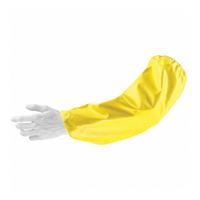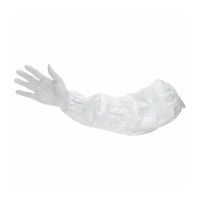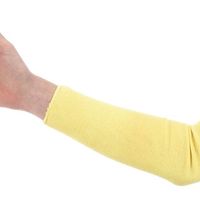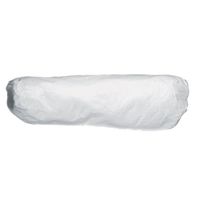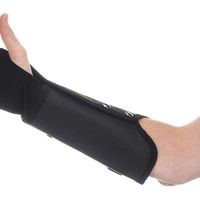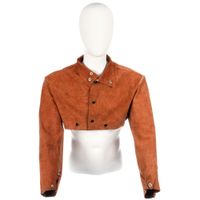Call +(254) 703 030 000 / 751 483 999 / 721 704 777
- Home
- Safety
- Hand Arm Protection
- Protective Sleeves
.....Read More
Frequently Asked Questions
What materials are commonly used in protective sleeves?
Protective sleeves are designed to safeguard various items, such as electronics, documents, and sports equipment, from damage. Common materials used in their construction include:
1. **Neoprene**: Known for its flexibility and cushioning properties, neoprene is often used in laptop and tablet sleeves. It provides excellent shock absorption and is water-resistant, offering protection against spills and light rain.
2. **Polyester**: This synthetic fabric is durable, lightweight, and resistant to stretching and shrinking. Polyester sleeves are often used for electronics and documents, providing a balance of protection and affordability.
3. **Nylon**: Similar to polyester, nylon is strong and resistant to abrasions. It is commonly used in protective sleeves for its durability and water-resistant properties, making it suitable for outdoor use.
4. **Leather**: Offering a premium look and feel, leather sleeves are popular for high-end electronics and documents. Leather provides good protection against scratches and minor impacts, though it is less water-resistant unless treated.
5. **Silicone**: Used primarily for phone and tablet sleeves, silicone is flexible and provides a good grip. It offers excellent shock absorption and is resistant to water and dust.
6. **Polyurethane (PU) Leather**: A synthetic alternative to leather, PU leather is used for its aesthetic appeal and cost-effectiveness. It offers moderate protection and is often used in sleeves for electronics and documents.
7. **Felt**: Made from wool or synthetic fibers, felt sleeves are soft and provide a unique texture. They offer basic protection against scratches and are often used for laptops and tablets.
8. **EVA Foam**: Ethylene-vinyl acetate foam is lightweight and provides excellent shock absorption. It is commonly used in protective sleeves for sports equipment and electronics.
These materials are chosen based on the specific protection needs, such as impact resistance, water resistance, and aesthetic preferences.
How do I choose the right protective sleeve for my needs?
To choose the right protective sleeve, consider the following factors:
1. **Device Compatibility**: Ensure the sleeve fits your device's dimensions. Check the manufacturer's specifications for size compatibility.
2. **Material**: Choose a material based on your needs:
- **Neoprene**: Offers good protection against scratches and minor impacts.
- **Leather**: Provides a premium look and feel, with moderate protection.
- **Polyester/Nylon**: Lightweight and often water-resistant, suitable for everyday use.
- **Hard Shell**: Offers maximum protection against drops and impacts.
3. **Protection Level**: Determine the level of protection needed:
- **Basic**: For scratch and dust protection.
- **Moderate**: For minor bumps and spills.
- **High**: For frequent travel or rugged environments.
4. **Portability**: Consider the sleeve's weight and bulk. A lightweight sleeve is ideal for portability, while a bulkier one may offer more protection.
5. **Design and Style**: Choose a design that suits your personal style and professional needs. Options range from sleek and minimalist to colorful and patterned.
6. **Additional Features**: Look for features like extra pockets for accessories, handles for easy carrying, or water-resistant coatings for added protection.
7. **Budget**: Set a budget that balances cost with the level of protection and features you need. Higher-priced sleeves often offer better materials and durability.
8. **Brand Reputation and Reviews**: Research brands known for quality and read customer reviews to gauge satisfaction and reliability.
By considering these factors, you can select a protective sleeve that meets your specific needs and preferences.
Are protective sleeves reusable or disposable?
Protective sleeves can be both reusable and disposable, depending on their material and intended use. Reusable protective sleeves are typically made from durable materials such as neoprene, silicone, or certain types of fabric. These sleeves are designed to withstand multiple uses and can be cleaned or sanitized between uses, making them suitable for long-term applications. They are often used in environments where durability and cost-effectiveness over time are important, such as in industrial settings or for personal protective equipment (PPE) in healthcare.
On the other hand, disposable protective sleeves are made from materials like polyethylene, polypropylene, or other lightweight plastics. These are intended for single-use applications where hygiene and contamination control are critical. Disposable sleeves are commonly used in medical, food processing, or laboratory settings where the risk of cross-contamination must be minimized. They are convenient for quick changes between tasks or shifts and are disposed of after use to ensure cleanliness and safety.
The choice between reusable and disposable protective sleeves depends on factors such as the level of protection required, cost considerations, environmental impact, and specific industry standards or regulations. Reusable sleeves may offer long-term savings and reduced environmental waste, while disposable sleeves provide convenience and enhanced hygiene in certain contexts.
What are the differences between cut-resistant and needlestick-resistant sleeves?
Cut-resistant sleeves are designed to protect against cuts and abrasions, typically made from materials like Kevlar, Dyneema, or other high-performance fibers. These materials are woven or knitted to create a barrier that resists being sliced by sharp objects such as knives or glass. The primary focus is on preventing lacerations and maintaining durability against sharp edges.
Needlestick-resistant sleeves, on the other hand, are specifically engineered to protect against punctures from needles or other fine, pointed objects. These sleeves often incorporate materials like tightly woven fabrics, metal mesh, or specialized coatings that provide a dense barrier to prevent penetration. The design focuses on stopping the sharp point of a needle from breaking through the fabric.
The key differences lie in their intended protection and construction. Cut-resistant sleeves prioritize resistance to slicing actions, while needlestick-resistant sleeves focus on preventing punctures. The materials and weaving techniques used in needlestick-resistant sleeves are often more complex and layered to provide the necessary density and strength to stop needle penetration.
In summary, while both types of sleeves offer protective qualities, cut-resistant sleeves are optimized for cuts and abrasions, and needlestick-resistant sleeves are tailored to prevent punctures from sharp, pointed objects.
How do I properly maintain and clean protective sleeves?
To properly maintain and clean protective sleeves, follow these steps:
1. **Regular Inspection**: Frequently check sleeves for any signs of wear, tear, or damage. Replace any that are compromised to ensure continued protection.
2. **Cleaning**: Use a soft, lint-free cloth to wipe down the sleeves. For deeper cleaning, use a mild soap solution and a damp cloth. Avoid harsh chemicals or abrasive materials that can damage the sleeve's surface.
3. **Drying**: After cleaning, ensure the sleeves are completely dry before use. Air drying is preferable. Avoid direct sunlight or heat sources, which can warp or degrade the material.
4. **Storage**: Store sleeves in a cool, dry place away from direct sunlight. Use a storage box or binder to keep them flat and prevent bending or creasing.
5. **Handling**: Always handle sleeves with clean hands to prevent transferring oils or dirt. Consider wearing gloves if handling valuable or sensitive items.
6. **Avoid Overloading**: Do not overfill sleeves, as this can cause stretching or tearing. Ensure the items fit comfortably within the sleeve.
7. **Rotation**: If using sleeves for display, rotate them periodically to prevent prolonged exposure to light or environmental factors that can cause fading or deterioration.
8. **Labeling**: Use non-adhesive labels or markers to avoid sticky residue that can attract dirt or damage the sleeve.
9. **Environmental Control**: Maintain a stable environment with controlled temperature and humidity to prevent mold or mildew growth.
10. **Professional Cleaning**: For valuable or antique sleeves, consider professional cleaning services to ensure proper care without risk of damage.
By following these guidelines, you can extend the life of your protective sleeves and ensure they continue to provide effective protection.
What standards should I look for in protective sleeves?
When selecting protective sleeves, consider the following standards:
1. **Material Quality**: Look for sleeves made from durable materials like polyethylene, polypropylene, or polyester. These materials offer good protection against dust, moisture, and physical damage.
2. **Acid-Free and Archival Quality**: Ensure the sleeves are acid-free and of archival quality to prevent degradation of the items stored within, especially for photographs, documents, or collectibles.
3. **Thickness**: Choose sleeves with appropriate thickness, typically measured in mils (thousandths of an inch). Thicker sleeves (3-5 mils) offer better protection but may be less flexible.
4. **Size and Fit**: Ensure the sleeves are the correct size for the items you intend to protect. They should fit snugly without being too tight, allowing for easy insertion and removal.
5. **Clarity**: Opt for sleeves with high clarity to ensure visibility of the contents without distortion. This is particularly important for display purposes.
6. **UV Protection**: If the items will be exposed to light, consider sleeves with UV protection to prevent fading and damage from ultraviolet rays.
7. **Sealability**: Some sleeves offer resealable flaps or closures to provide additional protection against dust and moisture.
8. **Anti-Static Properties**: For electronic components or sensitive items, anti-static sleeves can prevent static electricity damage.
9. **Reinforced Edges**: Reinforced or heat-sealed edges can provide additional durability and prevent tearing.
10. **Environmental Considerations**: Look for sleeves that are recyclable or made from recycled materials if environmental impact is a concern.
11. **Compliance with Standards**: Check for compliance with industry standards such as ISO 18902 for imaging materials or ANSI/NISO Z39.48 for permanence of paper.
By considering these standards, you can ensure that your protective sleeves offer the best possible protection for your items.
Can protective sleeves be used in combination with other personal protective equipment?
Yes, protective sleeves can be used in combination with other personal protective equipment (PPE). Protective sleeves are designed to shield the arms from various hazards such as cuts, abrasions, chemicals, and heat. They are often used in conjunction with other PPE to provide comprehensive protection in the workplace.
When combined with gloves, protective sleeves ensure that the entire arm and hand are safeguarded, which is crucial in environments where workers are exposed to sharp objects or hazardous substances. For instance, in industries like metalworking or glass handling, using both gloves and sleeves can prevent injuries from sharp edges or shards.
In environments where chemical exposure is a risk, protective sleeves can be worn with chemical-resistant suits and gloves to prevent skin contact with harmful substances. This layered approach is essential in laboratories or chemical plants where spills or splashes might occur.
For tasks involving high temperatures, such as welding or foundry work, heat-resistant sleeves can be paired with flame-retardant clothing and gloves to protect against burns. This combination is vital for ensuring safety in high-risk thermal environments.
Additionally, protective sleeves can be worn with aprons or full-body suits to provide extra coverage, especially when there is a risk of splashes or spills that could affect the arms.
Overall, the integration of protective sleeves with other PPE enhances safety by addressing specific risks associated with different parts of the body, ensuring that workers are adequately protected from head to toe. Proper training and assessment of workplace hazards are essential to determine the appropriate combination of PPE for any given task.
